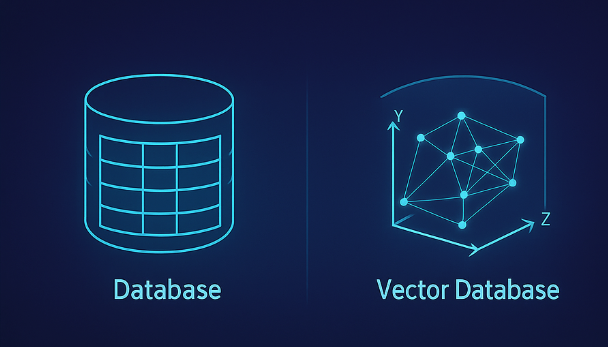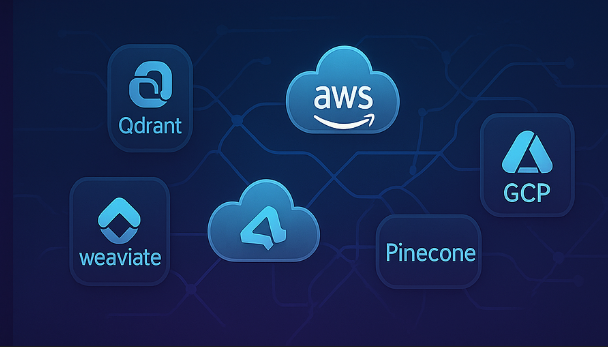Understanding AI-Native DB | 매거진에 참여하세요
Understanding AI-Native DB
#Vector #DB #AI #Search #pgvector #Pinecone #Weaviate #Implementa
AI-Native Databases & Vector Infra: The New Heart of Data Infrastructure
Databases (DBs) have long been the backbone of IT.
For decades, this seemed a “solved problem”
Oracle, MySQL, MongoDB, PostgreSQL, and others had already established stable ecosystems.
But by 2025, the landscape has changed.
Generative AI, multimodal search, and hyper-personalized services are reshaping how we store, retrieve, and leverage data.
It’s no longer enough to fetch numbers or strings quickly; contextual and semantic understanding has become critical.
This new paradigm is powered by AI-Native Databases & Vector Infrastructure.
What Is a Vector Database?
A vector database stores text, images, audio, and other data as numeric vectors, then calculates similarity for search.
Example:
Searching for “a dog playing in the park” doesn’t just match keywords; the database finds images closest in meaning using vectors.
In RAG (Retrieval-Augmented Generation) setups, like LLMs answering “trends in a startup VC landscape”,
the system pulls related vectorized reports to enhance responses.
Key Players:
Pinecone, Weaviate, Qdrant, Milvus, plus
traditional DBs extending with vector support : Postgres + pgvector, MongoDB Atlas Vector Search.

How Vectorization Works
Vectorization:
Transforming text, image, or audio into numeric arrays.
Cat -> [0.12, -0.87, 0.45, …]
Close to “dog”, far from “car” in vector space.
Embedding Models:
- Text: OpenAI text-embedding-3-large, HuggingFace BERT
- Images: CLIP, ResNet, Vision Transformer (ViT)
- Audio/Video: wav2vec, Whisper, VideoCLIP
- Storage & Indexing:
Dense vector storage: High-precision, exact similarity
Compressed/Quantized vector: Memory-efficient, slightly approximate
- Popular Indexing & Search Tech:
FAISS (Facebook AI Similarity Search): Optimized for k-NN search
HNSW (Hierarchical Navigable Small World Graph): Graph-based, fast on millions of vectors
IVF, PQ: Compressed storage, memory & speed optimized
Search Flow:
Query → vectorized → compared against stored vectors → top-K closest results
Distance metrics: cosine similarity or Euclidean (L2) distance
Formula (cosine similarity): similarity = (A · B) / (||A|| * ||B||)
Vector DB Workflow at a Glance
Step | Description | Typical Tech |
|---|---|---|
Data Input | Text, image, audio | Sentences, photos, sound |
Embedding | Convert to numeric vector | BERT, CLIP, Whisper |
Storage | Save high-dimensional vectors | FAISS, HNSW, IVF-PQ |
Query | Vectorize search input | text-embedding, CLIP |
Similarity | Compute distances | Cosine, L2 |
Output | Return top-K closest | Search results |
Comparing Leading Vector DB Solutions (2025)
Vendor | Strengths | Features | Limitations |
|---|---|---|---|
Pinecone | SaaS, serverless | Auto-scaling, hybrid search (HNSW + ScaNN) | Cost, vendor lock-in |
Weaviate | Open-source + cloud | GraphQL API, multimodal, plugins | Large-scale infra management |
Qdrant | Lightweight, fast | Rust-based, pgvector integration | Limited enterprise features |
Milvus | Large-scale optimization | Distributed clusters, video/image search | Operational complexity |
Postgres + pgvector | Familiar SQL + hybrid | Structured/unstructured mix, enterprise-friendly | Scalability for huge datasets |
MongoDB Atlas Vector | Developer-friendly | Vector + document search, cloud integration | Slightly lower performance than Pinecone |
AWS OpenSearch | AWS-native | Elasticsearch + vector, IAM/CloudWatch | Limited large-scale vector support |
Azure Cosmos DB | Global distribution | Multi-API, auto-scaling, RAG SDK | Complex pricing, learning curve |
Google AlloyDB / Vertex AI Search | AI-native GCP | Optimized pgvector, hybrid queries | Limited regions outside US |

Why AI-Native DBs Are Exploding Now
- RAG Standardization
: LLMs now rely on DBs to supplement missing knowledge.
- Multimodal Search
: Beyond text—images, audio, video all vectorized.
- Cloud Vendor Push
: AWS, Azure, GCP all offer vector support.
Traditional DB vs Vector DB
Not a battle—coexistence.
Traditional DBs: Transactions, finance, inventory → precision-critical
Vector DBs: Semantic search, recommendations, LLM augmentation → flexibility-critical
Many companies adopt a hybrid approach: Postgres + pgvector, Qdrant, etc.
Real-World Use Cases
- Notion AI: Document search & answer augmentation
- Spotify: Vectorized songs & lyrics → personalized recommendations
- Shopify: Product image search & AI shopping assistants
- Startups: Legal search, medical imaging prototyping with pgvector
Summary
AI-Native Databases & Vector Infrastructure are now the brain of AI systems.
For AI service planning or operations, choosing the right DB is no longer just a developer choice,
it’s a strategic decision that shapes user experience.






